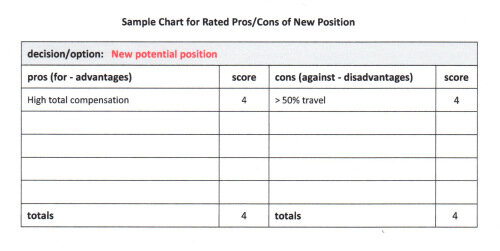An Effective Tool for Making Decisions
Several of my career counseling clients have recently come in to discuss whether to leave a job or take a new job offer. Getting a job offer can feel like a major achievement, especially in these post-recessionary times, but it is also stressful because you now have to decide whether to accept it!
Of course the roots for the answers lie not with the counselor per se, but in a clients’ understanding of the situation and ability to tap self-insight. Generally the client and I have undergone a fair amount of assessment related to work values, interests, strengths and personality preferences. We use that criterion to filter what we know about the decision at hand. Other times, however, clients feel genuinely stalled in what direction to take, or the opportunity and pending decision may arise with little notice and require a short response time. What do I advise in that instance?
Can’t decide? Try a Rated Pro-Con Table. A pro-con table is a simple exercise, almost deceptively so, and is one of the best ways to think through a difficult issue like whether or not to take a job, or choose between two offers. Even if no big decisions are pending for you currently, you might read through the exercise below and bookmark this blog, Career Transition: The Inside Job so you are better armed for the inevitable next big choice.
Benefits.
- A pro/con table can show both sides quickly so you can better see the entire picture. And, now that the factors of the decision are on paper, you can share it with your life partner or friends and invite their input or feedback.
- See if the pros truly outweigh the cons — assigning numerical ratings to weigh each factor helps you see their relative importance and get an overall total for each alternative.
- Realize how being true to – and acting on – your must-have values or priorities is essential to your sense of happiness, job fit and well-being at work.
Steps:
- Brainstorm
- List your issues, factors, considerations, etc. that provide evidence for or against (taking the job) on a separate piece of paper.
- Consider that a pro or con will have a related con or pro. For example, “high pay” may be a pro, but the corresponding con may be “> 50% travel/away from home.”
- See list below for additional common factors that you may have overlooked (do these areas make you realize you need more information before you can decide?).
- Assign a + (pro) or – (con) to each factor on list.
- Rate the positive or negative intensity or relative value of each factor 1 (low) to 4 (high).
- Transfer each factor from your list to the correct side of pro-con table (Word doc), with corresponding weight (#).
- Write in any other factors, rate, then sum each column.
- If you are trying to decide between staying at a present job or taking a new offer, you might use two tables and compare the sums of the pros and cons.
Sample Chart for Rated Pros/Cons of New Position

Common factors. Maybe you know there must be other factors in evaluating a job or new direction, but feel stumped. If so, consider the following five areas:
- RelationshipsThink about Managers, Peers and Subordinates—do you like the people? One of the biggest factors in employees sticking around is how they get along with their managers.
- Work/Life BalanceBe honest — how far and how much time are you willing to devote to your daily commute? Or consider the amount of work—is the culture one where there is frequent overtime?
- The Kind of WorkHow close is the mix of project work, building client relationships, developing strategy, implementing tactics or doing creative work to what you actually like to do?
- The CompanyAre the leaders of the company people you and others respect, admire and want to work for? Does the company provide products or services with which you would want to be associated?
- The MoneyAre you being offered a salary and benefits commensurate with your worth in the marketplace?
Conclusion. Throughout one’s career and life are various choice-points — Should I re-enter the workforce? Go back to school? Should I leave my current job? Should I accept a new job offer? While the rated pro-con chart is an imperfect tool, hopefully it can help corral some of the concerns bounding around in your head and tame the turmoil of choosing the best course of action.